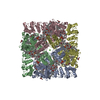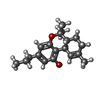[English] 日本語
 Yorodumi
Yorodumi- PDB-8sp8: Human TRP channel TRPV6 in cNW30 nanodiscs inhibited by tetrahydr... -
+ Open data
Open data
- Basic information
Basic information
| Entry | Database: PDB / ID: 8sp8 | ||||||||||||||||||
|---|---|---|---|---|---|---|---|---|---|---|---|---|---|---|---|---|---|---|---|
| Title | Human TRP channel TRPV6 in cNW30 nanodiscs inhibited by tetrahydrocannabivarin (THCV) | ||||||||||||||||||
 Components Components | Transient receptor potential cation channel subfamily V member 6 | ||||||||||||||||||
 Keywords Keywords | MEMBRANE PROTEIN / phyto-cannabinoid / phytocannabinoid / cannabindoid / tetrahydrocannabivarin / THCV / transient receptor potential V family member 6 / TRP / human / channel / closed / TRPV6 / TRP channels / cancer / oncochannel / cNW30 / nanodiscs / circularized nanodiscs / nanodisc / vanilloid | ||||||||||||||||||
| Function / homology |  Function and homology information Function and homology informationparathyroid hormone secretion / regulation of calcium ion-dependent exocytosis / TRP channels / calcium ion import across plasma membrane / calcium ion homeostasis / calcium channel complex / response to calcium ion / calcium ion transmembrane transport / calcium channel activity / calcium ion transport ...parathyroid hormone secretion / regulation of calcium ion-dependent exocytosis / TRP channels / calcium ion import across plasma membrane / calcium ion homeostasis / calcium channel complex / response to calcium ion / calcium ion transmembrane transport / calcium channel activity / calcium ion transport / calmodulin binding / metal ion binding / identical protein binding / plasma membrane Similarity search - Function | ||||||||||||||||||
| Biological species |  Homo sapiens (human) Homo sapiens (human) | ||||||||||||||||||
| Method | ELECTRON MICROSCOPY / single particle reconstruction / cryo EM / Resolution: 2.79 Å | ||||||||||||||||||
 Authors Authors | Neuberger, A. / Yelshanskaya, M.V. / Nadezhdin, K.D. / Sobolevsky, A.I. | ||||||||||||||||||
| Funding support |  United States, United States,  Germany, 5items Germany, 5items
| ||||||||||||||||||
 Citation Citation |  Journal: Nat Commun / Year: 2023 Journal: Nat Commun / Year: 2023Title: Molecular pathway and structural mechanism of human oncochannel TRPV6 inhibition by the phytocannabinoid tetrahydrocannabivarin. Authors: Arthur Neuberger / Yury A Trofimov / Maria V Yelshanskaya / Jeffrey Khau / Kirill D Nadezhdin / Lena S Khosrof / Nikolay A Krylov / Roman G Efremov / Alexander I Sobolevsky /   Abstract: The calcium-selective oncochannel TRPV6 is an important driver of cell proliferation in human cancers. Despite increasing interest of pharmacological research in developing synthetic inhibitors of ...The calcium-selective oncochannel TRPV6 is an important driver of cell proliferation in human cancers. Despite increasing interest of pharmacological research in developing synthetic inhibitors of TRPV6, natural compounds acting at this channel have been largely neglected. On the other hand, pharmacokinetics of natural small-molecule antagonists optimized by nature throughout evolution endows these compounds with a medicinal potential to serve as potent and safe next-generation anti-cancer drugs. Here we report the structure of human TRPV6 in complex with tetrahydrocannabivarin (THCV), a natural cannabinoid inhibitor extracted from Cannabis sativa. We use cryo-electron microscopy combined with electrophysiology, calcium imaging, mutagenesis, and molecular dynamics simulations to identify THCV binding sites in the portals that connect the membrane environment surrounding the protein to the central cavity of the channel pore and to characterize the allosteric mechanism of TRPV6 inhibition. We also propose the molecular pathway taken by THCV to reach its binding site. Our study provides a foundation for the development of new TRPV6-targeting drugs. | ||||||||||||||||||
| History |
|
- Structure visualization
Structure visualization
| Structure viewer | Molecule:  Molmil Molmil Jmol/JSmol Jmol/JSmol |
|---|
- Downloads & links
Downloads & links
- Download
Download
| PDBx/mmCIF format |  8sp8.cif.gz 8sp8.cif.gz | 878.2 KB | Display |  PDBx/mmCIF format PDBx/mmCIF format |
|---|---|---|---|---|
| PDB format |  pdb8sp8.ent.gz pdb8sp8.ent.gz | 753.7 KB | Display |  PDB format PDB format |
| PDBx/mmJSON format |  8sp8.json.gz 8sp8.json.gz | Tree view |  PDBx/mmJSON format PDBx/mmJSON format | |
| Others |  Other downloads Other downloads |
-Validation report
| Summary document |  8sp8_validation.pdf.gz 8sp8_validation.pdf.gz | 2.9 MB | Display |  wwPDB validaton report wwPDB validaton report |
|---|---|---|---|---|
| Full document |  8sp8_full_validation.pdf.gz 8sp8_full_validation.pdf.gz | 2.9 MB | Display | |
| Data in XML |  8sp8_validation.xml.gz 8sp8_validation.xml.gz | 83.4 KB | Display | |
| Data in CIF |  8sp8_validation.cif.gz 8sp8_validation.cif.gz | 115.3 KB | Display | |
| Arichive directory |  https://data.pdbj.org/pub/pdb/validation_reports/sp/8sp8 https://data.pdbj.org/pub/pdb/validation_reports/sp/8sp8 ftp://data.pdbj.org/pub/pdb/validation_reports/sp/8sp8 ftp://data.pdbj.org/pub/pdb/validation_reports/sp/8sp8 | HTTPS FTP |
-Related structure data
| Related structure data |  40676MC M: map data used to model this data C: citing same article ( |
|---|---|
| Similar structure data | Similarity search - Function & homology  F&H Search F&H Search |
- Links
Links
- Assembly
Assembly
| Deposited unit | 
|
|---|---|
| 1 |
|
- Components
Components
-Protein , 1 types, 4 molecules ABCD
| #1: Protein | Mass: 76555.203 Da / Num. of mol.: 4 Source method: isolated from a genetically manipulated source Source: (gene. exp.)  Homo sapiens (human) / Gene: TRPV6, ECAC2 / Plasmid: pEG BacMam / Cell line (production host): HEK293 / Production host: Homo sapiens (human) / Gene: TRPV6, ECAC2 / Plasmid: pEG BacMam / Cell line (production host): HEK293 / Production host:  Homo sapiens (human) / Variant (production host): suspension-adapted cells / References: UniProt: Q9H1D0 Homo sapiens (human) / Variant (production host): suspension-adapted cells / References: UniProt: Q9H1D0 |
|---|
-Non-polymers , 5 types, 50 molecules 








| #2: Chemical | ChemComp-Y01 / #3: Chemical | ChemComp-POV / ( #4: Chemical | ChemComp-I8E / #5: Chemical | ChemComp-CA / | #6: Chemical | ChemComp-CL / | |
|---|
-Details
| Has ligand of interest | Y |
|---|
-Experimental details
-Experiment
| Experiment | Method: ELECTRON MICROSCOPY |
|---|---|
| EM experiment | Aggregation state: PARTICLE / 3D reconstruction method: single particle reconstruction |
- Sample preparation
Sample preparation
| Component | Name: sample 1 / Type: COMPLEX / Entity ID: #1 / Source: RECOMBINANT | |||||||||||||||||||||||||
|---|---|---|---|---|---|---|---|---|---|---|---|---|---|---|---|---|---|---|---|---|---|---|---|---|---|---|
| Molecular weight | Value: 0.07648 MDa / Experimental value: NO | |||||||||||||||||||||||||
| Source (natural) | Organism:  Homo sapiens (human) Homo sapiens (human) | |||||||||||||||||||||||||
| Source (recombinant) | Organism:  Homo sapiens (human) / Cell: Human embryonic kidney 293 / Plasmid: pEG BacMam Homo sapiens (human) / Cell: Human embryonic kidney 293 / Plasmid: pEG BacMam | |||||||||||||||||||||||||
| Buffer solution | pH: 8 | |||||||||||||||||||||||||
| Buffer component |
| |||||||||||||||||||||||||
| Specimen | Conc.: 2.58 mg/ml / Embedding applied: NO / Shadowing applied: NO / Staining applied: NO / Vitrification applied: YES Details: tetrameric oncochannel, human TRP channel, hTRPV6, in cNW30 lipid nanodiscs and soybean lipids in complex with and inhibited by the phytocannabinoid tetrahydrocannabivarin (THCV) | |||||||||||||||||||||||||
| Specimen support | Grid material: GOLD / Grid mesh size: 300 divisions/in. / Grid type: UltrAuFoil R1.2/1.3 | |||||||||||||||||||||||||
| Vitrification | Instrument: FEI VITROBOT MARK IV / Cryogen name: ETHANE / Humidity: 100 % / Chamber temperature: 277 K |
- Electron microscopy imaging
Electron microscopy imaging
| Experimental equipment |  Model: Titan Krios / Image courtesy: FEI Company |
|---|---|
| Microscopy | Model: TFS KRIOS |
| Electron gun | Electron source:  FIELD EMISSION GUN / Accelerating voltage: 300 kV / Illumination mode: FLOOD BEAM FIELD EMISSION GUN / Accelerating voltage: 300 kV / Illumination mode: FLOOD BEAM |
| Electron lens | Mode: BRIGHT FIELD / Nominal defocus max: 2000 nm / Nominal defocus min: 800 nm / Cs: 2.7 mm |
| Image recording | Average exposure time: 2 sec. / Electron dose: 60 e/Å2 / Film or detector model: GATAN K3 (6k x 4k) / Num. of grids imaged: 1 / Num. of real images: 6699 |
| Image scans | Width: 5760 / Height: 4092 |
- Processing
Processing
| EM software |
| ||||||||||||||||||||||||||||||||||||||||
|---|---|---|---|---|---|---|---|---|---|---|---|---|---|---|---|---|---|---|---|---|---|---|---|---|---|---|---|---|---|---|---|---|---|---|---|---|---|---|---|---|---|
| CTF correction | Type: NONE | ||||||||||||||||||||||||||||||||||||||||
| Particle selection | Num. of particles selected: 4502785 | ||||||||||||||||||||||||||||||||||||||||
| 3D reconstruction | Resolution: 2.79 Å / Resolution method: FSC 0.143 CUT-OFF / Num. of particles: 213249 / Symmetry type: POINT | ||||||||||||||||||||||||||||||||||||||||
| Atomic model building | Space: REAL | ||||||||||||||||||||||||||||||||||||||||
| Atomic model building | PDB-ID: 7S8C Accession code: 7S8C / Source name: PDB / Type: experimental model | ||||||||||||||||||||||||||||||||||||||||
| Refine LS restraints |
|
 Movie
Movie Controller
Controller


 PDBj
PDBj









